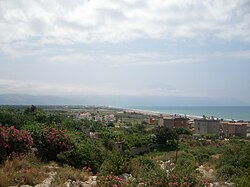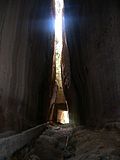Top Qs
Timeline
Chat
Perspective
Samandağ
District and municipality in Hatay, Turkey From Wikipedia, the free encyclopedia
Remove ads
Samandağ, formerly known as Süveydiye (Arabic: السويدية, romanized: al-Sūwaydiyya), is a resort town and municipality and district of Hatay Province, Turkey.[2] Its area is 384 km2,[3] and its population is 123,447 (2022).[1] It lies at the mouth of the Asi River on the Mediterranean coast, near Turkey's border with Syria, 25 km (16 mi) from the city of Antakya. In February 2023, the town was heavily damaged by powerful earthquakes.
Remove ads
Etymology
Samandağ was formerly known as Suweydiye - Arabic for “the black one", in reference to the local roe deer.[4] The Armenian name of the town "Svetia" (Սվեդիա) was derived from the Arabic one.
It was also nicknamed Yukarı Alevışık (Turkish: "Hill of the Alevis/Alawites) and Levşiye (likely the corrupted Arabic form of the ancient name of Seleucia).[5]
It was forcibly renamed Samandağ (Seman-Dağ, Turkish for the Arabic Jabal Sem'an: St. Simeon Mountain[6]) in 1948, part of a systematic campaign to erase local Arab and Armenian heritage through Turkification.
Remove ads
History
Summarize
Perspective
Samandağ lies near the site of the ancient Seleucia Pieria, founded in 300 BC after the Persian Empire was ousted from the region by Seleucus Nicator, a general of Alexander the Great, in the Seleucid era that followed Alexander's demise. Seleucia Pieria quickly became a major Mediterranean port of the Hellenistic and Roman eras, the port of Antioch. However, it was subject to silting and an earthquake in 526 finally completed its demise as a port.
During the 6th century, Saint Simeon Stylites the Younger lived on Saman Dağı, a nearby mountain that is also known in Christian sources as the "Wondrous Mountain" or the "Admirable Mountain."[7]
Samandağ, then called St Symeon,[8] became the port of Antioch. The area was conquered by the Rashidun Caliphate in 637 after the Battle of the Iron Bridge and later it came under the control of the Umayyad and Abbasid Arab dynasties. It was then reconquered by the Byzantines under Nikephoros II Phokas but later conquered by the Seljuk Turks under general Afşin Bey after the Battle of Manzikert which resulted in a disastrous defeat for the Byzantines. It played an important role in the capture of the city by the Crusaders in 1098, to be known as Soudin. The area was known as Svediye.
There were originally six Armenian villages; Bityas, Kabousiye, Haji Habibly, Kheder Beg, Yoghoun Olouk and Vakif. After the French government agreed to cede Hatay Province to Turkey in 1939, all Armenian villagers (with the exception of some from Vakif) emigrated to Anjar, Lebanon. Vakıflı, the village's modern name, is the only remaining Armenian village in Turkey, with 103 inhabitants (2022).[9][10]
Remove ads
Geography
Summarize
Perspective
Samandağ itself is a small town, about 22 km (14 mi) from the city of Antakya. The local economy depends on fishing and agriculture, especially citrus fruits, and Samandağ has the air of a country market town, with young men buzzing through the streets on mopeds. Around the midtown of Çevlik (derived from Seleucia), there is a long sandy coastline popular with daytrippers from Antakya, although the sea can be stormy. This is an important nesting area of the endangered sea turtle Caretta caretta.
Climate
Samandağ has a hot-summer Mediterranean climate (Köppen: Csa).[11] Summers are hot and dry, with high humidity and very warm nights. Winters are mild and rainy.
Composition
There are 42 neighbourhoods in Samandağ District:[13]
- Ataköy
- Atatürk
- Avcılar
- Batıayaz
- Büyükoba
- Çamlıyayla
- Çanakoluk
- Cemalgürsel
- Ceylandere
- Çiğdede
- Çöğürlü
- Çubuklu
- Cumhuriyet
- Değirmenbaşı
- Deniz
- Eriklikuyu
- Fidanlı
- Gözene
- Hıdırbey
- Huzurlu
- Kapısuyu
- Karaçay
- Koyunoğlu
- Kurtderesi
- Kuşalanı
- Mağaracık
- Meydan
- Mızraklı
- Seldiren
- Şükrü Kanatlı
- Sutaşı
- Tekebaşı
- Tomruksuyu
- Uzunbağ
- Vakıflı
- Yaylıca
- Yeni
- Yeniköy
- Yeşilada
- Yeşilköy
- Yeşilyazı
- Yoğunoluk
Remove ads
Population
The vast majority of the population is composed of Arabs who adhere to the Alawism, and speak the Levantine Arabic dialect like the rest of Syria and Lebanon from which they were forcibly split. There are also Sunni Arabs, Antiochian Orthodox Arabs (around 2,000) and Turks.
Local politics
Politically Samandağ is traditionally left-leaning. In the 2009 local elections, Freedom and Solidarity Party (ÖDP) candidate Mithat Nehir was elected mayor of the ilçe with 34.20% of the votes (the CHP candidate got 31.77%, the AKP one 14.07%) he was then the sole victorious ÖDP candidate in the entire republic.[14] In September 2013, he joined the CHP under which banner he successfully contested the next 2014 local elections.[15] In the local elections in March 2019 Refik Eryılmaz was elected Mayor for the Republican People's Party (CHP).[16] The current District Governor is Murat Kütük.[17]
Remove ads
Places of interest
This section needs expansion. You can help by adding to it. (December 2017) |
- Inside view of the Vespasian Tunnel
- Exit of the Vespasian Tunnel
- Monastery of St Simeon Stylites the Younger
- The Vespasianus Titus Tunnel, in the village of Kapısuyu , built as a water channel in the 2nd century.
- The Shrine of Khidr.
- Vakıflı, the only remaining Armenian village in Turkey.[18][10]
- Monastery of Simeon Stylites the Younger
Remove ads
See also
References
External links
Wikiwand - on
Seamless Wikipedia browsing. On steroids.
Remove ads






